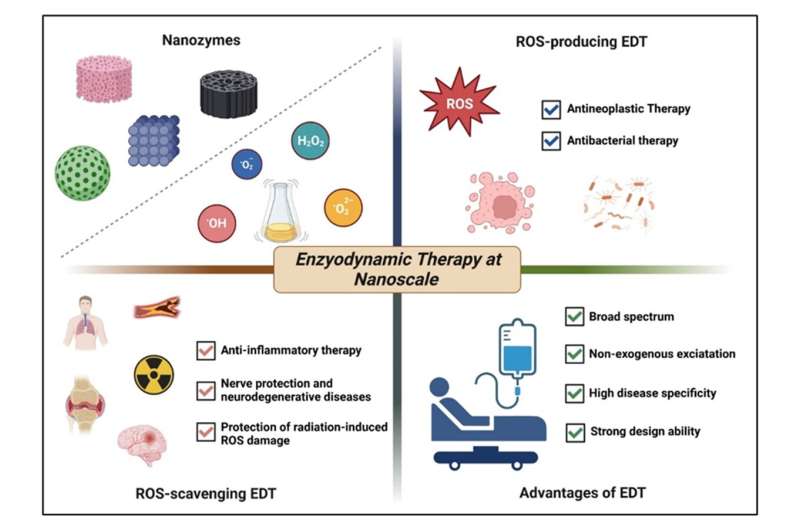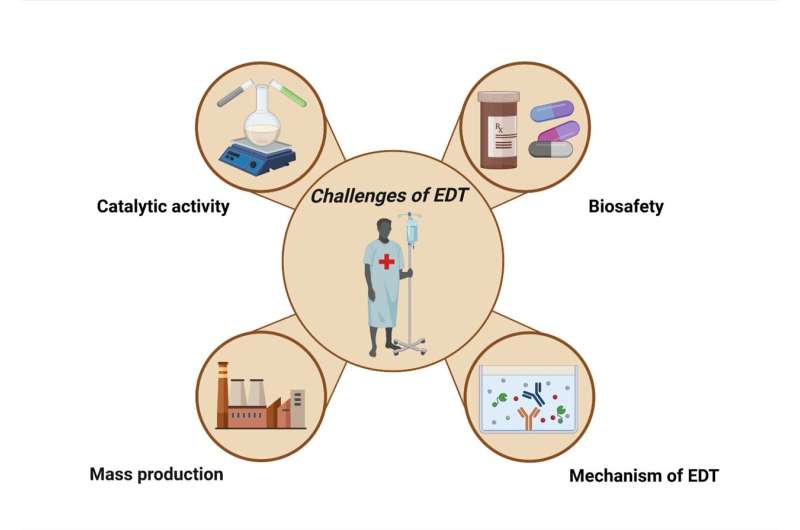This article has been reviewed according to Science X's editorial process and policies. Editors have highlighted the following attributes while ensuring the content's credibility:
fact-checked
proofread
Enzyodynamic therapy at nanoscale

Enzyodynamic therapy (EDT) is a new type of reactive oxygen species (ROS)-related dynamic therapeutic modality, which adequately utilizes the enzyme-triggered catalytic reactions in living organisms and achieves disease treatment through controlling the generation or elimination of ROS. ROS refers to a highly active chemical substance containing oxygen free radicals in the body or natural environment. ROS at physiological concentration is beneficial for the development of living organisms.
However, excessive ROS production causes oxidative damage, which is linked to a multitude of diseases including malignancies, neurodegeneration, cardiovascular disease, inflammation, and so on.
A recent review, published in MedComm—Biomaterials and Applications, was designed by Prof. Yu Chen and written by his postdoctoral researcher Dr. Zeyu Wang and Ph.D. student Hui Huang (Materdicine Lab, School of Life Sciences, Shanghai University, Shanghai, China).
A surge of nanomaterials with unique ROS-regulating properties have been extensively applied in various biomedical fields. Among them, a type of nanomaterial called nanozyme features the catalytic abilities of enzymes, which can respond to external excitation and then trigger internal biochemical responses in tissue to produce or consume ROS.
According to material types, nanozymes are primarily classified into the following several categories, including metal, metal oxides, metal sulfides, carbon-based materials, composite materials and some emerging organic nanosystems.
Alternatively, they can be divided into the specific oxidoreductase family, hydrolase family, lyase family, and so on, based on their intrinsic catalytic types. Zeyu and Hui systematically introduced the oxidoreductases including oxidase (OXD), glucose oxidase (GOD), peroxidase (POD), catalase (CAT), superoxide dismutase (SOD) and glutathione peroxidase (GPx)-like nanozymes.

The essence of catalysis is that the catalyst changes the reaction path and guides the reaction along a path with lower activation energy for accelerating the reaction rate.
Therefore, the primary goal of the research on the catalytic mechanism of nanozymes is to reveal the process of atomic rearrangement of reactants on the surface of nanozyme materials, identify the reaction pathway and kinetics with the lowest activation energy, establish the laws of their chemical composition and structure affecting catalytic efficiency, and provide a basis for the research and design of nanozymes.
Based on this, Zeyu and Hui reviewed the main catalytic mechanism of oxidoreductases, including POD, OXD, CAT, and SOD. They also listed nearly all available factors of regulation of nanozyme activity.
Since various nanozymes feature distinct characteristics for ROS production or clearance, Zeyu and Hui comprehensively summarized the representative strategies of EDT to treat different types of diseases by regulating the ROS level, mainly including ROS producing-based diseases, such as cancer, bacterial infection, and ROS scavenging-involved diseases, including inflammation and neurodegeneration.
Based on a thorough understanding and summary of the classification and catalytic mechanism of nanozymes, regulation of nanozyme activity as well as the research progresses of nanozyme-enabled/augmented enzyodynamic therapy, Zeyu and Hui also provided novel insights regarding the challenges and opportunities faced by EDT. This comprehensive review is beneficial to the development of EDT-based therapeutic strategies.
More information: Zeyu Wang et al, Enzyodynamic therapy at nanoscale, MedComm—Biomaterials and Applications (2023). DOI: 10.1002/mba2.53
Provided by Sichuan International Medical Exchange and Promotion Association



















